- About
- Services
Digital Marketing Services
Consulting Services
 Strategic Planning
Strategic Planning Digital Ads Audits
Digital Ads Audits Conversion Optimization
Conversion Optimization Team Training
Team Training
- Business Tools
- Resources
Ultimate Guide to PPC
Pay per click (PPC) advertising – also called paid search – is a powerful way to guarantee traffic for your website and cultivate new customers. Paid search enables you to grab web visitors whose buying intent is high – when someone goes into a search engine and types, “I’m looking for XYZ in my town,” they’re ready to make a purchase.
In fact, according to Wordstream, which makes a suite of online advertising tools, paid search ads account for 64.6% of clicks when people are searching keywords with “high commercial intent.” If you skip PPC advertising, you risk missing those clicks.
PPC also helps companies to balance out their SEO efforts, which can be particularly useful for smaller organizations competing in specific localities.
I’m a big proponent of showing up on search engine results pages because you’ve written excellent, compelling content that is genuinely useful for your target audience when they’re searching for a service like yours. (Read our “Ultimate Guide to SEO in Jacksonville, FL” for guidance to mastering local SEO here in Jacksonville).
However, in competitive markets, SEO takes time to build and start working. In the meantime, you can stack the deck by supplementing your SEO efforts with PPC campaigns that target those keyword phrases you’re trying to win and that you know have high commercial intent.
It’s also a great way to claim more of the Page One real estate in search results. It means you could potentially show up (1) in the ad at the top of the page, (2) in the “Local Three Pack” that highlights three local businesses, and (3) in the organic search listings on page one. You could dominate the page by pursuing both SEO and PPC placement simultaneously.
Note: In this guide, I will be focusing on Google AdWords specifically.
Why? In part, it’s simple math. Google owns over 70% of the search market share. But it’s also partly because Google isn’t just a search engine; it’s the engine behind a wide network of services and platforms through which your ads can reach people all across the web. No other search engine comes even close to Google’s reach in online advertising.
Benefits of Pay Per Click for Jacksonville, FL Businesses
#1 – Guaranteed Placement
Pay per click on Google guarantees top placement for relevant keyword searches from targeted local consumers. Because paid search ads appear at the very top of the page, they’re the first listings that visitors see. Interestingly, nearly half (46%) of web searchers can’t identify paid ads on the search results page, so they treat them as equivalent to organic search listings. The result is that 41% of all clicks go to the top 3 paid ads on the search results page. Although this guide focuses on Google AdWords, you can also set up campaigns with Bing and Yahoo! Pay per click will maintain top placement on all search engines where you use it.
#2 – Low Competition and Low Cost
For the most part, there is still very little competition in Jacksonville and North Florida on pay per click. This means that pay per click advertising can be extremely cost-effective. Users pay for ad position based on a bidding system, so you’re competing with other advertisers. Less competition means lower costs and higher ROI. In fact, many of my clients can pick up high-value traffic and new business for pennies per click. If you’ve ever worried that PPC istoo expensive, that may be true if you’re competing nationally, but it’s NOT true AT ALL when competing locally in the Jacksonville market.
#3 – Increased Traffic and Exposure
PPC campaigns essentially mean guaranteed traffic. Further, here’s an interesting statistic: according to Google Research, 89% of traffic generated by search ads is not replaced by organic clicks when ads are stopped. In other words, you’re reaching an audience and generating traffic that is distinct from SEO-driven traffic, so you’re reaching more and different customers than you would get with SEO alone.
#4 – It Works for Any and All Keyword Phrases
You can build as many PPC campaigns as you want. You can gain placement on any keyword phrase that is relevant to your business. For example, if you are trying to place for a highly competitive keyword phrase where SEO efforts are taking a long time, you can simply turn on a paid search campaign and instantly show up.
#5 – Supplement and Complement SEO
Both SEO and PPC campaigns have advantages and disadvantages, but the interesting thing is that the disadvantages of one are typically the advantages of the other. That means they work extremely well when used in tandem. For example, SEO can be unpredictable, but PPC is guaranteed, efficient, and easy to control. Also, SEO visitors might be seeking information, whereas PPC traffic is often ready to buy – half of PPC visitors arrive on your website already geared to make a purchase.
HOW TO START A PPC CAMPAIGN?
I’m not going to get into the weeds in this guide with all the settings and campaign configurations available with Google Ads because there are a lot of them. Instead, I will discuss the six major points that affect overall strategy – listed below – and show you how to get started with them.
- Targeting
- Keywords
- Ad Copy
- Landing Pages
- Bid Strategy and Budget
- Tracking
Note that a “set it and forget it” approach will deliver very poor results in PPC campaigns. Google Ads is a 24/7 non-stop advertising machine. The landscape is constantly shifting, and you must keep up with it. Keyword lists need to be expanded/contracted, ad copy needs to be edited, and keyword bids need to be adjusted every week and month if you want to achieve great results.
This is the problem I encounter most often when taking over the marketing from a previous vendor, especially in Jacksonville. The client’s Google Ads account was created, but it was NOT tended to properly. As a result, it generated subpar – and sometimes outright dismal – results.
With that word of warning, let’s dive into the main components of a Google Ads campaign.
Getting Started with PPC
#1 – TARGETING
Search or Display Advertising
When you start setting up your campaign in Google, this is the first step.
Google lets you pick which channels within Google you want to use for your advertising campaign: Search or Content/Display.
Search means the ads that show up when someone uses Google to search for a term. Content/Display means advertising in all the corners of Google’s online empire – websites, mobile apps, platforms like YouTube, apps like Gmail and Google Docs, etc.
For the purposes of this guide, we will focus strictly on Search campaigns – those that appear when a user performs a search on Google.com. These campaigns typically reach users with the highest buying intent.
Geographic Targeting
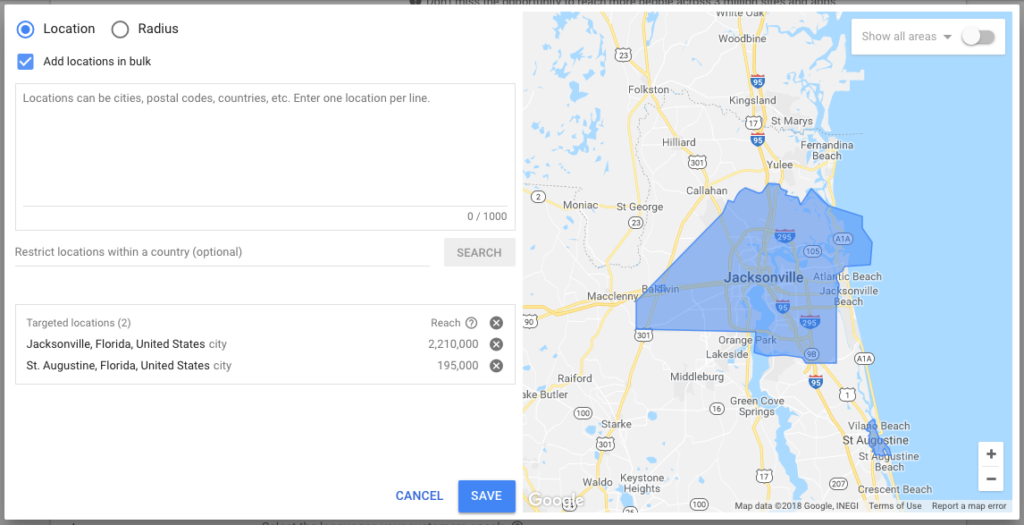
You then get to choose which geographic market in which you want your ads to appear. This means you need to consider:
- Do you want to advertise in all of North Florida?
- Or, just Jacksonville? St. Augustine?
- Or, even just a few specific zip codes?
Google’s geographic targeting feature allows you to advertise as broadly or narrowly as you like.
Ad Scheduling
Google also allows you to choose which times your ads run each day. For example, your ads can run based on your hours of operation, like 8 a.m. – 6 p.m. Choosing this option will allow you to prevent consumers from seeing and clicking on your ad when your business is not open to answer questions or tend to their needs.

Alternatively, you might keep your ads running 24/7. This is more important for service-oriented businesses like doctors, plumbing, AC repair, auto repair, salons, etc. where consumers need to call in advance and book an appointment.
Getting Started with PPC
#2 – KEYWORD RESEARCH & SELECTION
Step 1 is all about setup, but Step 2 is the true fulcrum of success in PPC. If you want to run a solid pay per click campaign in Jacksonville, FL, getting the keywords right will be your most important area of focus.
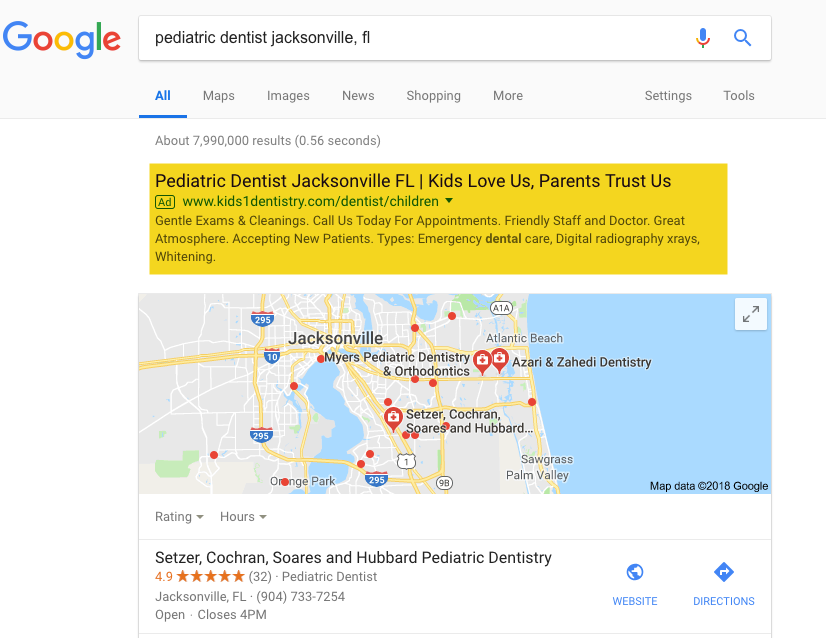 Happily, Ads competition is low in the Jacksonville-North Florida market. Very few local Jacksonville-based businesses within each industry are using Google Ads. This has been great news for my clients because I’ve been able to run low-cost campaigns that have brought them tons of new customers.
Happily, Ads competition is low in the Jacksonville-North Florida market. Very few local Jacksonville-based businesses within each industry are using Google Ads. This has been great news for my clients because I’ve been able to run low-cost campaigns that have brought them tons of new customers.
For example, I have one client who offers healthcare-related services ranging from $1,500 to $5,000 per service. They specialize in one area, and they’re the only such specialist in the North Florida area. That means we can pick up relevant keywords for pennies. Their ROI on PPC is through the roof!
But ROI also depends on catching the right customers, and that means good keyword selection is critical to running a quality pay per click campaign in Jacksonville.
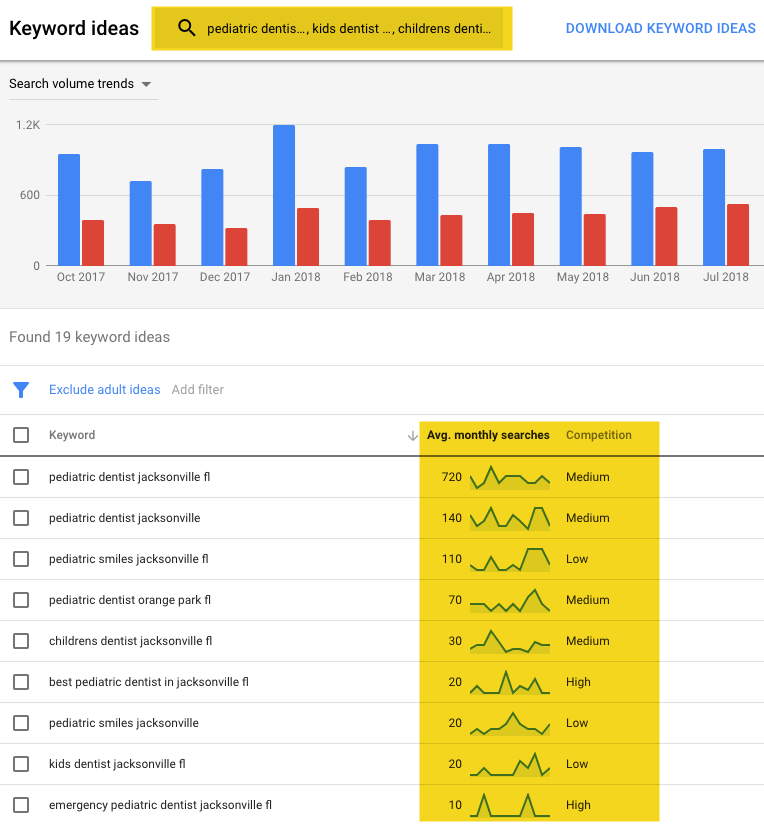
Generate a list of keywords for every service or product that you offer; each revenue stream in your business needs its own keyword list. For example:
- Auto insurance Jacksonville fl
- Ponte vedra sports massage
- St Augustine ac repair
- Estate attorney orange park fl
- Commercial AC repair Jacksonville beach
- Etc.
Be sure to include the location for local PPC campaigns. The two keyword phrases “AC repair” versus “AC repair Jacksonville FL” have two very different price points. The geo-specific keyword has little competition, so you can capture clicks at a low cost. The generic term will be much more expensive.
Ultimately, you’ll want to brainstorm as many relevant keyword phrases as you can. The bigger the list, the more potential customers you will reach.
In the short term, however, it’s easy to get overwhelmed in building out keywords. In my experience, it’s important to start small. Focus on building a keyword list around your two or three most profitable services or products. Get those ads live and generating good traffic, then move on to the other small services your company provides.
This method of scaling has never failed me (or my clients)!
Getting Started with PPC
#3 – AD COPY
The ad copy is the catalyst that generates the clicks. It’s what prospective customers actually see so it must reach out and say “click me” to them.
First, use your keyword in your ad title. This is the first signal to a consumer that your ad is relevant to what they are searching for.
Then, focus on including a mix of unique benefits and/or features in your ads, along with any promotional offer or warranty that is available. Ideally, these unique benefits/features will be unique to the local market.
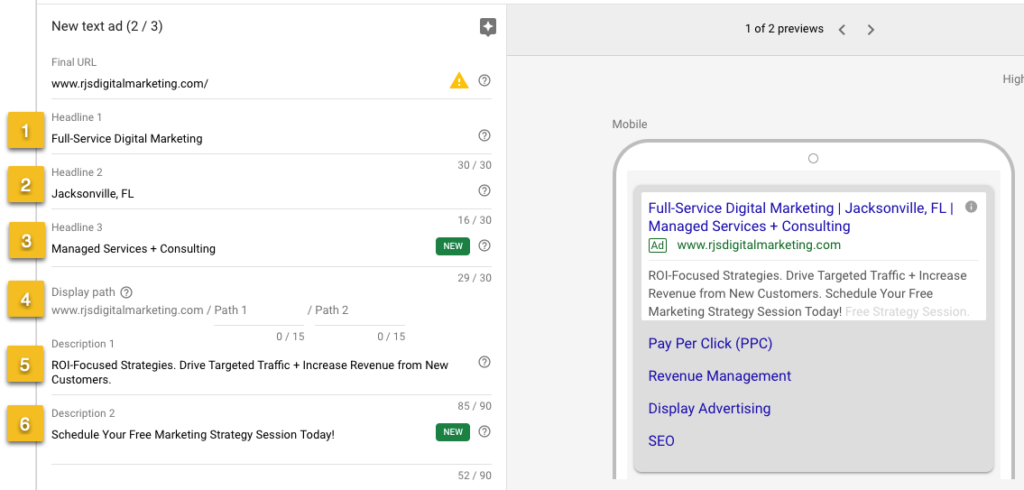
You can run up to 6 different versions of ads. This allows you to test different versions to see which performs best. I suggest running at least a couple and testing different benefits/features and different offers in each. Through testing, you’ll figure out what makes greater numbers of potential customers respond faster, and you can begin to sculpt your offerings to better fit their needs.
Getting Started with PPC
#4 – LANDING PAGES
Landing pages are the sales tools of your website. Treat them with respect, care, and a lot of thoughtfulness when creating them.
That, of course, can be labor-intensive, so most people use the Homepage as the landing page. This is a BIG mistake.
If consumers arrive on your website and they have to search and navigate around to find what they are looking for, they’ll hit the back button and leave. That’s what happens when they hit your homepage first.
A well-designed landing page with a clear and powerful call-to-action will be far more relevant to your visitors and will convert at much higher numbers than your homepage.
For most Jacksonville and North Florida businesses and companies, having a single dedicated page to describe each service or product that you offer is the absolute best strategy. (Also, service-specific landing pages will help with SEO; see my “Ultimate Guide to SEO in Jacksonville” for more information).
7 Landing Page Elements that Guarantee Pay Per Click Success
- Include differentiators. Spell out how you are unique from the local competition.
- Highlight the benefits of using your service or buying your product.
- Identify compelling features that come with hiring your company.
- Described the process for how the service or product is performed or delivered.
- Showcase testimonials and reviews from past customers.
- Make any relevant promotional offers.
- Don’t forget a strong call-to-action to get started!
Use these 7 landing page elements to craft winning landing pages for each service and/or product that you provide.
Getting Started with PPC
#5 – BID STRATEGY & BUDGET
Pay per click is priced based on a bidding system.
PPC is a 24/7 live-running auction where the advertiser sets a bid on every keyword phrase they want to advertise on. You are bidding for ad rank or placement versus other advertisers for each keyword phrase.
Luckily, as stated before, there is typically very little competition in the Greater Jacksonville market with pay per click, so you can still start relatively inexpensive PPC campaigns in Jacksonville, FL as well as the surrounding communities.
That said, I typically recommend a starting budget between $1,500 to $3,000 per month to adequately gain good placement on a wide variety of keyword phrases in North Florida. This is a very solid starting point that will generate a very strong – and noticeable – increase in traffic for the top three to four services/products that you offer.
What’s your bidding strategy?
With your budget set, you can choose from a ton of bidding strategies available in Google AdWords (and also Bing AdCenter, if you use it). Bidding is highly, highly customizable in both Google AdWords and Bing AdCenter.
With flexibility comes complexity, however. These strategies can get very confusing for those who are inexperienced with the platforms and their bidding structure. They include factors that can lead you to spend way too much money far too quickly, like:
- Bidding on the wrong keyword phrases.
- Using the wrong keyword match types.
- Targeting the wrong geographic markets.
- Utilizing the wrong bidding strategies that automatically increase/decrease your bids based on a number of factors.
Nothing will undermine your results like a poorly run campaign. If you don’t know what you’re doing, you can bleed through money quickly and yet still see only minimal results from your campaigns.
I strongly recommend letting a pro, like myself, handle the day-to-day maintenance of these accounts so you don’t have to spend the time and resources necessary to become knowledgeable and comfortable with the ad platforms that you use. That way, you’ll be able to gain more targeted traffic at a lower cost.
You can program the bidding system to increase bids on certain keyword phrases on specific days or just in certain zip codes within North Florida, or even within certain hours of each day. In other words, the most impactful ways to customize your keyword bidding strategies include:
- Bidding by Geography
- Bidding by Device
- Bidding by Time
- Bidding by Day
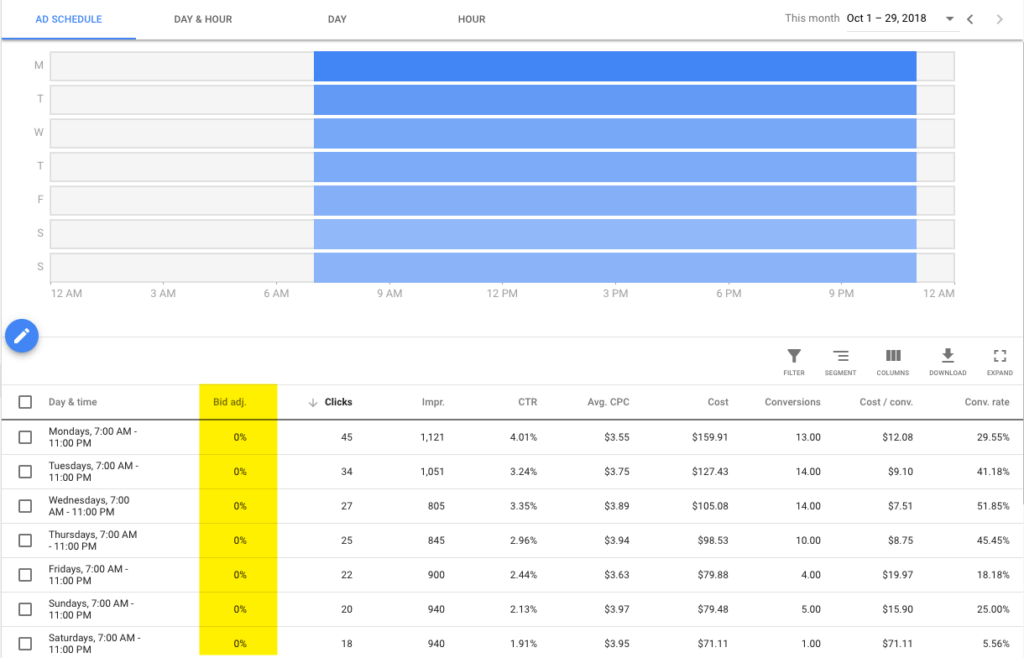
For example, if you are a restaurant in downtown Jacksonville and want to advertise your lunch special, you can configure the system to increase your bid price every Monday – Friday by 25% from 10 am – 2 pm for the keyword phrase Downtown Jacksonville restaurants and lunch restaurants downtown Jacksonville, FL
Google AdWords will automatically increase the bids for those keywords, and you’ll receive higher rankings and thus more traffic during those times.
Advanced Bidding Strategies
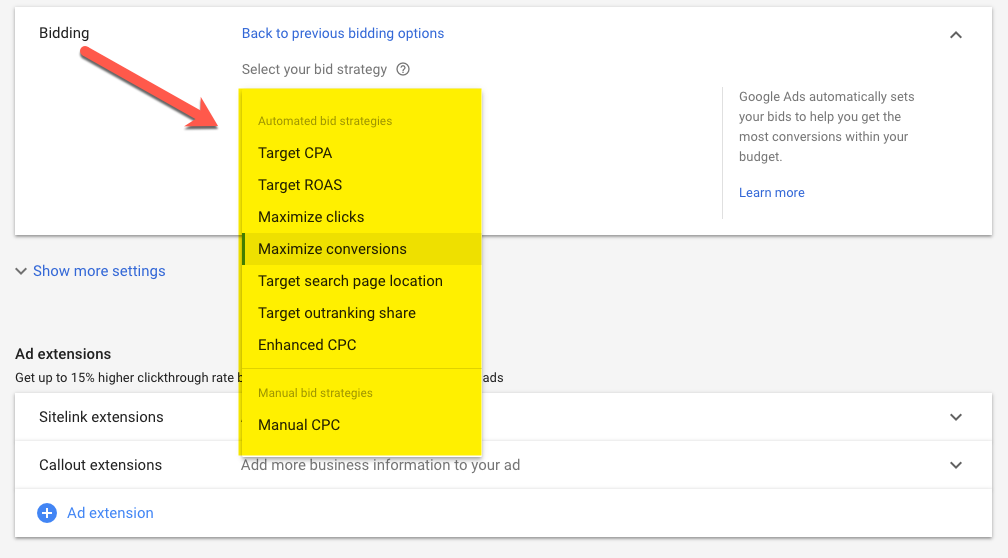
I just want to briefly touch on the more advanced bidding strategies available. Google and Bing give you a huge range of bidding strategies, like:
- Maximize clicks
- Top page bidding
- Target cost per acquisition
- Target return on ad spend
- Target outranking share
- And even more
You can really get into the weeds here. Automated bidding strategies are great once your campaigns are well established, and you have a good idea of conversion rate and cost per acquisition. Once you are familiar and comfortable with those metrics, automated bidding strategies will work to your benefit.
Until then, the safest play is to manually adjust bids yourself or let a pro do it for you.
Getting Started with PPC
#6 – TRACKING & REPORTING
Tracking performance and making any necessary adjustments to the strategy to improve results is a crucial step in determining campaign success.
Google AdWords Tracking
Google AdWords provides its own tracking capabilities independent of Google Analytics. It’s a simple code snippet that you place on your confirmation or thank you pages. The code can be customized based on your specific type of conversion.
Implementing the Google AdWords conversion tracking then allows you to calculate your cost per acquisition for each sale or lead. With that information, you can adjust your campaigns to improve results.
Google Analytics Tracking
Your Google AdWords campaigns can be linked to your Google Analytics account, importing all campaign metrics into your Google Analytics tracking suite.
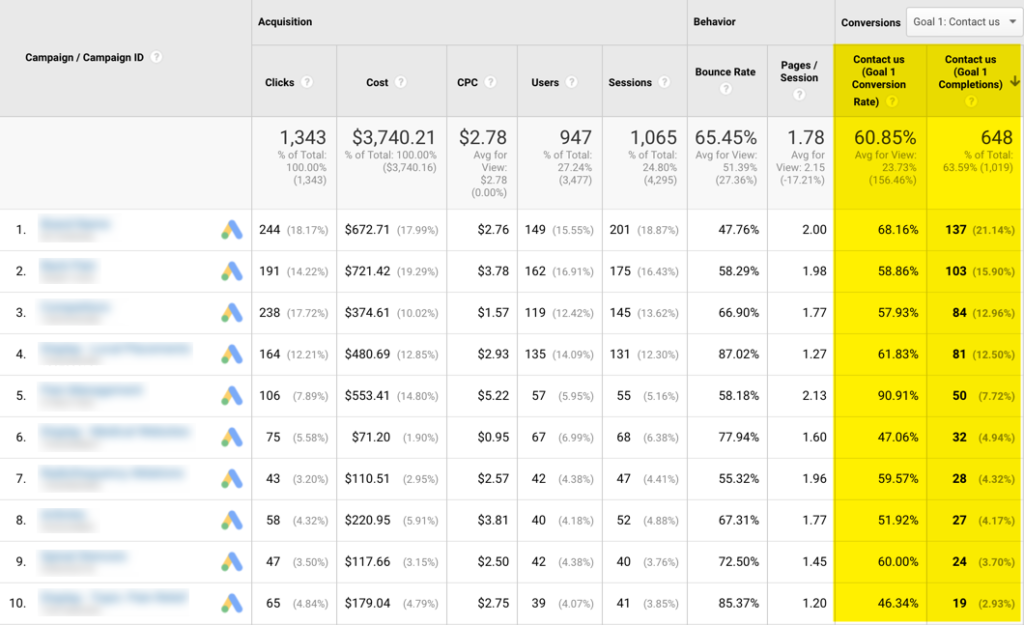
This is very beneficial because it gives you a full scope view into how your Google AdWords traffic is performing on your website, providing far more valuable insights than just tracking if a user converted or not. Those insights include information like:
- City the user lives in,
- The page they entered the website on,
- Bounce rate,
- All pages they visited on your website,
- If they left and returned to the website a few days later,
- And more.
Use those insights to help you in your overall marketing efforts.
Google Analytics can also track conversions in two ways: Goals and Ecommerce. Goals allow you to track if the user performed one of the desired actions on your website. Ecommerce lets you track sales on your site.
Call Tracking
In addition to tracking online conversions, some people still prefer to pick up the phone and call the business to speak with an associate to have more specific questions answered.
For this, I HIGHLY recommend call tracking.
This tracks all inbound phone calls originating from digital marketing efforts, like campaigns on Google AdWords. This service captures the keyword phrase the user searched to find your website, as well as the basic call information: phone number, the city where the call was placed, call duration, etc.
It’s easy to implement and scales up as your marketing and business grow.


















